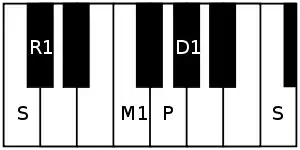| Arohanam | S R₁ M₁ P D₁ Ṡ |
|---|---|
| Avarohanam | Ṡ N₃ D₁ P M₁ G₃ R₁ S |
| Carnatic music |
|---|
 |
| Concepts |
| Compositions |
| Instruments |
|
Saveri (pronounced sāvēri) is a Carnatic music ragam. This raga is a janya of the 15th Melakarta raga Mayamalavagowla. This raga brings out karuna rasa, i.e. it brings mood of compassion.[1]
Structure and Lakshana

Ascending scale with Shadjam at C

Descending scale with Shadjam at C
This ragam is an Audava-Sampurna ragam (five notes in the ascending scale and seven notes in the descending scale).
- ārohaṇa: S R₁ M₁ P D₁ Ṡ[lower-alpha 1]
- avarohaṇa: Ṡ N₃ D₁ P M₁ G₃ R₁ S[lower-alpha 2]
The notes are shuddha rishabham, shuddha madhyamam and shuddha dhaivatam in ascending scale and kakali nishadam, shuddha dhaivatam, shuddha madhyamam, antara gandharam and shuddha rishabham in descent. The two swaras which give the raga such a characteristic are R (Rishabham) and D (Dhaivatham).
Select compositions
- Sarasuda, a varnam composed by Kotavasal Venkatarama Iyer, set to Adi tala
- Sankari Sankuru, Durusuga and Janani Natajana composed by Shyama Sastri
- Bhavayaami Raghuraamam (first raga used in this ragamalika), Anjaneya Raghuraamam, Paripahi Ganadhipa, Pahimam Sripadmanabha and Devi Pavane (Navarathri third day krithi) by Maharaja Swathi Thirunal
- Rama Bana, Tulasi Jagajjanani and Daridapu Leka – Adi Tala composed by Thyagaraja
- Kari Kalabha Mukham in Tisra Ekam composed by Muthuswamy Dikshitar
- Sri Rajagopala in Adi composed by Muthuswamy Dikshitar
- Etu Namminavo Manasa by Patnam Subramania Iyer
- Pahimam Girithanaye and Somapoma composed by Irayimman Thampi
- Velayya Daya composed by Koteeswara Iyer
- Sriramula divyanama by Bhadrachala Ramadasu
- Murugu Muruga by Periyasaamy Thooran
- Venkataramanane baro, Parakumadade, Barayya Venkataramana by Purandaradasa
- Bhasurangi Bale and Hemopameyaangi two padams by Swathi Thirunal
- Janakasutha a Geetham
- Kapali iruka, muruga Muzhumathi by Papanasam sivan
Related rāgams
This section covers the theoretical and scientific aspect of this rāgam.
Scale similarities
- Karnataka Shuddha Saveri is a pentatonic scale which has a symmetric descending scale as the ascending scale, which is same as the ascending scale of Saveri, while Saveri has a sampurna descending scale. Its ārohaṇa-avarohaṇa structure is S R1 M1 P D1 S : S D1 P M1 R1 S
- Malahari is a audava-shadava scale (5 notes in ascending and 6 in descending scale) that resembles Saveri.[2] Its ascending scale has shuddha madhyamam in place of antara gandharam, while the nishadham is dropped in descending scale. Its ārohaṇa-avarohaṇa structure is S R1 M1 P D1 S : S D1 P M1 G3 R1 S
Notes
References
This article is issued from Wikipedia. The text is licensed under Creative Commons - Attribution - Sharealike. Additional terms may apply for the media files.